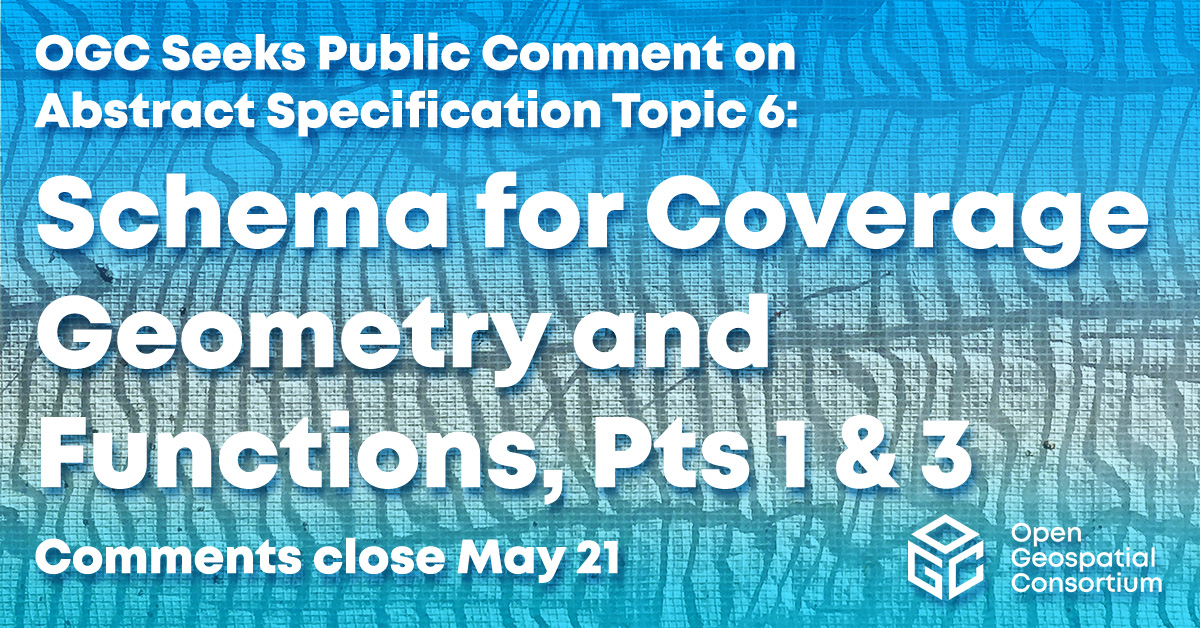Request Closed: April 21, 2023 9:00 am — May 21, 2023 11:59 pm (AoE)
The Open Geospatial Consortium (OGC) seeks public comment on Parts 1 (Fundamentals) & 3 (Processing Fundamentals) of the OGC Abstract Specification Topic 6: Schema for Coverage Geometry and Functions. Comments are due by May 21, 2023.
OGC Abstract Specification Topic 6: Schema for Coverage Geometry and Functions – Part 1: Fundamentals (also adopted as ISO 19123-1), defines, at a high, implementation-independent level, the notion of coverages as digital representations of space-time varying phenomena, corresponding to the notion of a field in physics. Such coverages can be discrete or continuous.
Part 1 of this new edition cancels and replaces the 2007 edition of Topic 6 which has been technically revised. The main changes are as follows:
- the document has been renamed as Part 1: Fundamentals to permit Part 3 in the OGC Abstract Specification Topic 6 and support ISO publication of a 3-part Coverage Standard (Part 2 is the same as the OGC Coverage Implementation Schema Standard);
- the text has been simplified for better understanding;
- concepts, while in principle unchanged, have been defined more rigorously and some errors have been corrected;
- the approach to standardization taken in the document has been changed. The new edition of the document defines a high-level, generic concept of coverages with an interface definition from which many different (not necessarily interoperable) implementation structures can be derived.
- all operations except evaluate() have been removed, for simplification purposes. ISO 19123-3 (aka Part 3: Processing fundamentals) is to take over the operations part;
- the Scope has been extended to include Mesh;
- the concept of discrete and continuous coverages has been generalized to achieve an improved conceptual basis and to allow for coverages that are discrete along some domain axes and continuous along other domain axes.
- updates in ISO 19103 have been reflected, and corresponding adjustments have been made where necessary; the informative Annex on “UML notation” has been deleted since this is now described in ISO 19103.
- all coordinate-related definitions are based on ISO 19111, and corresponding adjustments have been made in all places necessary;
- the definition of image CRS has been moved from ISO 19111 to this document;
- the definition of interpolation is now based on the interpolation definition of ISO 19107 in order to avoid duplicate and diverging definitions.
OGC Abstract Specification Topic 6: Schema for Coverage Geometry and Functions – Part 3: Processing Fundamentals (also adopted as ISO 19123-3), defines, at a high, implementation-independent level, a coverage processing language for server-side extraction, filtering, processing, analytics, and fusion of multi-dimensional geospatial coverages representing, for example, spatiotemporal sensor, image, simulation, or statistics datacubes. Services implementing this language provide access to original or derived sets of coverage information, in forms that are useful for client-side consumption. Part 3 is a conceptual abstraction of the OGC Web Coverage Processing Service Standard.
OGC Members interested in staying up to date on the progress of this standard, or contributing to its development, are encouraged to join the Coverages SWG via the OGC Portal.
The candidate Abstract Specification Topic 6 Schema for Coverage Geometry and Functions – Part 1: Fundamentals (07-011r1) (.PDF) and Part 3: Processing Fundamentals (21-060r1) (.PDF) are available for review and comment on the OGC Portal. Comments are due by May 21, 2023, and should be submitted via the method below.
To Comment:
Comments can be submitted to a dedicated email reflector for a period ending on the “Close request date” listed above. Comments received will be consolidated and reviewed by OGC members for incorporation into the document. Please submit your comments via this email address, using this Comments Template for the message body.
Subscribe to Comments:
You may wish to subscribe to the distribution list to receive comments as they are submitted. Subscribing to the list will also allow you to view comments already received, which can be found in the List Archives.
